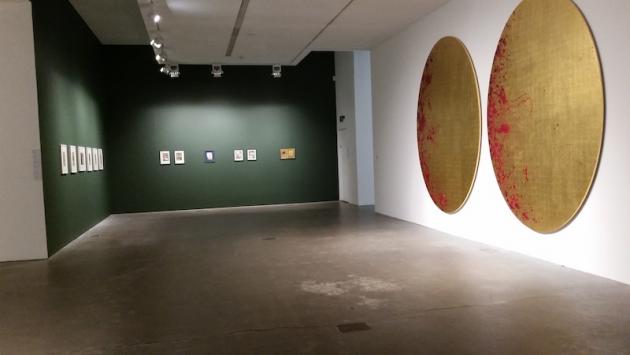The Deutsche Bank ‘Artist of the Year, Imran Qureshi has created intricate miniature paintings and colossal site-specific installations to form an impressive exhibition at the Ikon Gallery in Birmingham.
Pakistani born Qureshi is one of the most important contemporary artists from the subcontinent. Synthesizing traditional motifs and techniques with current issues and the formal language of contemporary abstract painting, Qureshi creates a pull between death and the living, the body and the landscape, juxtaposing beauty and the suggestion of conflict. Qureshi’s miniatures are adorned with gold and blood-red paint. Flowers become bloody forms, a snippet of content that overflows with detail.
A translucent shirt sits central within a small frame. Delicate flowers escape the edge of the border, caught between the urban backdrop of a brick wall and a glistening pane of Gold that sits behind it. Petals, like bloody splatters, clothe the empty shirt alluding to the form of a body. Fleshy leaves, their stalks like blood vessels, suggest a body’s interior; in the absence of an actual body, they wrap and form themselves as flesh within the hollow shirt.
Qureshi sits a flower-dressed shirt against a bricked wall, reminding his viewer of human habitats and behaviours; clothes hanging on a washing line; the mundane. Painting a deep night sky that is littered with clouds, Qureshi presents the image in a tiny frame, emphasizing it as being just a glimpse into someone’s life.
By referring the viewer to the landscape, Qureshi encourages them to read the flowers within their usual context. However, within the same frame exists a deserted shirt that is cloaked in suggestion of human presence, created by the spotting of flowers like blood stains. Qureshi encourages the viewer to read the image as being the flesh of a human, whilst at the same time placing the image within the context of a landscape.
(The flesh of the earth, the flesh of the human, death and living; the circle of life?) From one scale to the next, ‘And they still seek traces of blood’ (2013) is a gigantic installation scaling the length of the second floor gallery. Images from earlier works by the artist are printed on thousands of sheets of paper, crumpled and gathered to form a mountainous bodily heap.
The structure is a force to be reckoned with. Leaving little space between the installation and the ceiling, the viewer becomes a tiny figure within a great and uncomfortable mass; one that strongly references death, blood and violence. Each undistinguishable crumpled sheet is merged with its neighbour. The volume, 30,000 sheets, reflects the faceless deaths that are the result of mass conflict. Each mound, form or body is as unidentifiable as the other, emphasized by the title which quotes a poem by Faiz Ahmed Faiz, about those who have been buried without their lives being honoured.
Continuing the variation of his medium, Qureshi creates several moving image works within the exhibition. In a small, dark room, a long and thin bench faces a large screen. Gold forms emerge from white, slowly dissolving, reemerging. They drift, twist and float, the breath of the projector their only sound. Their form – like birds, slowly tumbling from flight – seems weightless, unbound, unfixed. A contorted twisting motion could reference the ‘giving in’ of a form, the ‘letting go’ of life, a ‘drifting into’ unconsciousness. They fall and rise without speed or effort. Within the context of the exhibition, are they caught in an in-between? Purgatory? Amidst the violence and inescapable references to blood and violence, Qureshi creates peace; a stillness that leaks from the screen, gently softening the black walls of the small room. Instilled in the viewer is a sense of calm, perhaps suggestive of the quiet we find in death.
The work exhibits skill with a variety of materials and scales, whilst remaining unified in message. Qureshi incorporates personal observations on every day life in present-day Pakistan into his work, whilst acknowledging that violence can be met with, not only in his native country, but in many cultures and societies world wide.
Words/Photo By Becca Harris © Artlyst 2014
Imran Qureshi, at the Ikon Gallery until 25th January 2015.

